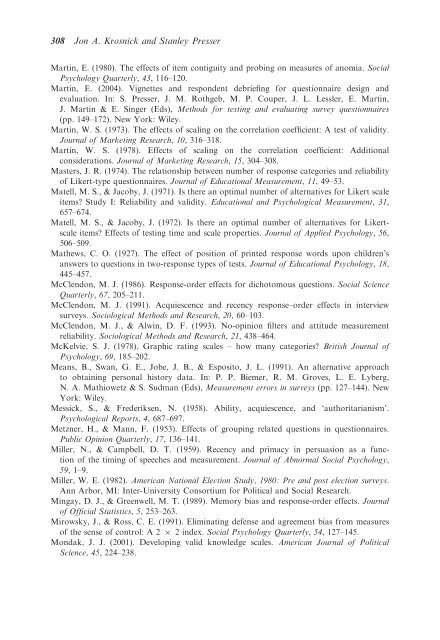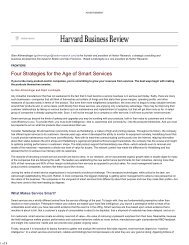Question and Questionnaire Design - Stanford University
Question and Questionnaire Design - Stanford University
Question and Questionnaire Design - Stanford University
Create successful ePaper yourself
Turn your PDF publications into a flip-book with our unique Google optimized e-Paper software.
308 Jon A. Krosnick <strong>and</strong> Stanley PresserMartin, E. (1980). The effects of item contiguity <strong>and</strong> probing on measures of anomia. SocialPsychology Quarterly, 43, 116–120.Martin, E. (2004). Vignettes <strong>and</strong> respondent debriefing for questionnaire design <strong>and</strong>evaluation. In: S. Presser, J. M. Rothgeb, M. P. Couper, J. L. Lessler, E. Martin,J. Martin & E. Singer (Eds), Methods for testing <strong>and</strong> evaluating survey questionnaires(pp. 149–172). New York: Wiley.Martin, W. S. (1973). The effects of scaling on the correlation coefficient: A test of validity.Journal of Marketing Research, 10, 316–318.Martin, W. S. (1978). Effects of scaling on the correlation coefficient: Additionalconsiderations. Journal of Marketing Research, 15, 304–308.Masters, J. R. (1974). The relationship between number of response categories <strong>and</strong> reliabilityof Likert-type questionnaires. Journal of Educational Measurement, 11, 49–53.Matell, M. S., & Jacoby, J. (1971). Is there an optimal number of alternatives for Likert scaleitems? Study I: Reliability <strong>and</strong> validity. Educational <strong>and</strong> Psychological Measurement, 31,657–674.Matell, M. S., & Jacoby, J. (1972). Is there an optimal number of alternatives for Likertscaleitems? Effects of testing time <strong>and</strong> scale properties. Journal of Applied Psychology, 56,506–509.Mathews, C. O. (1927). The effect of position of printed response words upon children’sanswers to questions in two-response types of tests. Journal of Educational Psychology, 18,445–457.McClendon, M. J. (1986). Response-order effects for dichotomous questions. Social ScienceQuarterly, 67, 205–211.McClendon, M. J. (1991). Acquiescence <strong>and</strong> recency response–order effects in interviewsurveys. Sociological Methods <strong>and</strong> Research, 20, 60–103.McClendon, M. J., & Alwin, D. F. (1993). No-opinion filters <strong>and</strong> attitude measurementreliability. Sociological Methods <strong>and</strong> Research, 21, 438–464.McKelvie, S. J. (1978). Graphic rating scales – how many categories? British Journal ofPsychology, 69, 185–202.Means, B., Swan, G. E., Jobe, J. B., & Esposito, J. L. (1991). An alternative approachto obtaining personal history data. In: P. P. Biemer, R. M. Groves, L. E. Lyberg,N. A. Mathiowetz & S. Sudman (Eds), Measurement errors in surveys (pp. 127–144). NewYork: Wiley.Messick, S., & Frederiksen, N. (1958). Ability, acquiescence, <strong>and</strong> ‘authoritarianism’.Psychological Reports, 4, 687–697.Metzner, H., & Mann, F. (1953). Effects of grouping related questions in questionnaires.Public Opinion Quarterly, 17, 136–141.Miller, N., & Campbell, D. T. (1959). Recency <strong>and</strong> primacy in persuasion as a functionof the timing of speeches <strong>and</strong> measurement. Journal of Abnormal Social Psychology,59, 1–9.Miller, W. E. (1982). American National Election Study, 1980: Pre <strong>and</strong> post election surveys.Ann Arbor, MI: Inter-<strong>University</strong> Consortium for Political <strong>and</strong> Social Research.Mingay, D. J., & Greenwell, M. T. (1989). Memory bias <strong>and</strong> response-order effects. Journalof Official Statistics, 5, 253–263.Mirowsky, J., & Ross, C. E. (1991). Eliminating defense <strong>and</strong> agreement bias from measuresof the sense of control: A 2 2 index. Social Psychology Quarterly, 54, 127–145.Mondak, J. J. (2001). Developing valid knowledge scales. American Journal of PoliticalScience, 45, 224–238.
















